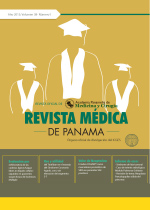Características Clínicas y Epidemiológicas de la Microhematuria Asintomática Aislada Persistente (MHAAP) en Pacientes Pediátricos, Servicio de Nefrología del Hospital De Especialidades Pediátricas Omar Torrijos Herrera.
Autores/as
DOI:
https://doi.org/10.37980/im.journal.rmdp.2016423Resumen
Resumen
La microhematuria asintomática aislada persistente (MHAAP) es una entidad que se considera de curso benigno si no se asocia durante su seguimiento con eventos renales adversos. Sin embargo, hay quienes alertan que podría tratarse de un hallazgo predictivo de ERC, tal como lo es la proteinuria.
Objetivo: conocer las características clínicas y epidemiológicas de la microhematuria asintomática aislada persistente en pacientes pediátricos atendidos en la consulta externa de Nefrología del Hospital de Especialidades Pediátricas Omar Torrijos Herrera en el año 2013.
Metodología: se revisó la lista de registro diario de pacientes con hematuria de la consulta externa de nefrología del año 2013 y se escogieron los pacientes con microhematuria asintomática aislada persistente, donde se revisaron los expedientes clínicos.
Resultados:
Un total de 38 casos fueron incluidos. La edad de presentación se ubicó entre los 5 a 9 años de edad, con una relación sexo femenino masculino de 2:1. El 28,98% de los pacientes presentó proteinuria la cual en todos los casos fue transitoria.
Causas: 9 (23,68%) pacientes con Hematuria familiar benigna, 3 (7,89%) pacientes con Síndrome de Alport, 2 (5.26%) pacientes con Hipercalciuria, 1 (2.63%) paciente con Ectasia renal, 1 (2.63%) paciente con Nefrocalcinosis y 2 (5.26 %) pacientes con nefritis aguda subclínica. En 20 (57,89%) pacientes no se encontró causa alguna.
Conclusiones: la principal causa definida de MHAAP fue de origen glomerular. En el periodo de estudio no se observó progresión de daño renal.
Abstract
The persistent isolated asymptomatic microhematuria (MHAAP as followed by its initials in Spanish) is an entity that is considered to have a benign course if not associated during its follow-up with adverse renal events. However, there are those who warn that it could be a predictive discovery of ERC, such as it is the proteinuria.
Objective: get to know the clinical and epidemiological characteristics of the persistent isolated asymptomatic microhematuria in pediatric patients treated at the outpatient of Nephrology of the specialty Hospital of pediatric specialties Omar Torrijos Herrera in the year 2013.
Methodology: we reviewed the list of daily record of patients with hematuria in the year 2013 of the Nephrology department of the outpatient section of the hospital and selected patients with persistent isolated asymptomatic microhematuria.
Results:
A total of 38 cases were included. The age of presentation was between 5 to 9 years of age, with a 2:1 male female ratio. 28.98% of patients had transient proteinuria.
Causes: 9 (23,68%) patients with benign familial Hematuria, 3 (7.89%) patients with Alport syndrome, 2(5.26%) patients with hypercalciuria, 1 (2.63%) patient with renal Ectasia, 1 (2.63%) patient with nephrocalcinosis and 2 (5.26%) with subclinical acute post streptococal glomerulonephritis. 22 (57,89%) patients did not find any cause.
Conclusions: the leading cause defined was of glomerular origin. No adverse renal events witnessed since our study is medium-term.
Publicado
Número
Sección
Licencia
Derechos autoriales y de reproducibilidad. La Revista Médica de Panama es un ente académico, sin fines de lucro, que forma parte de la Academia Panameña de Medicina y Cirugía. Sus publicaciones son de tipo acceso gratuito de su contenido para uso individual y académico, sin restricción. Los derechos autoriales de cada artículo son retenidos por sus autores. Al Publicar en la Revista, el autor otorga Licencia permanente, exclusiva, e irrevocable a la Sociedad para la edición del manuscrito, y otorga a la empresa editorial, Infomedic International Licencia de uso de distribución, indexación y comercial exclusiva, permanente e irrevocable de su contenido y para la generación de productos y servicios derivados del mismo. En caso que el autor obtenga la licencia CC BY, el artículo y sus derivados son de libre acceso y distribución.






